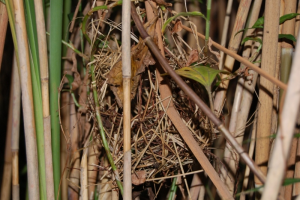Weaver species
Choose different species from drop-down list and press 'Go' button. See Full species list.Yellow Bishop Euplectes capensis
IUCN: Least concern Discovery: 009Categories: Linnaeus, nectar, pest, Nest use, black and yellow bishops,
News items about species
Discovery
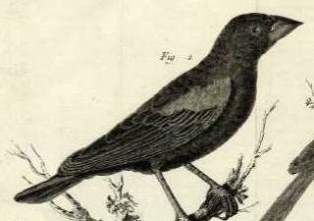
figure from Brisson 1760 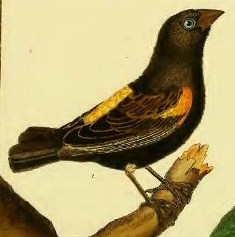
figure from Daubenton 1783 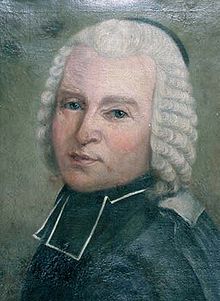
figure from wikipedia 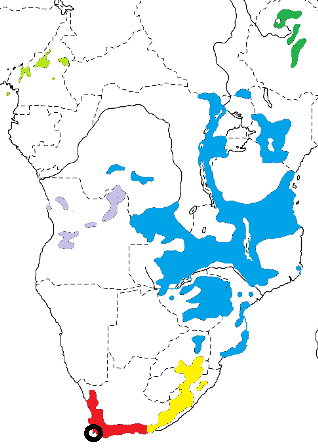
type locality circled IntroductionLinnaeus (1766) briefly descriped the Yellow Bishop, based on the longer description in Brisson 1760. Mathurin Jacques Brisson, a French zoologist, gave the names "Le Pincon du Cap de Bonne Esperance" (French) and Fringilla Capitis Bonae Spei (Latin). Brisson's painting clearly shows the wing patch of the male.Brisson noted that the Yellow Bishop originated from the Cape of Good Hope, from where specimens had been sent to RAF de Reaumur by Nicolas Louis de La Caille. de La Caille, a French astronomer, visited Table Bay (Cape Town) and went up the West Coast as far as Aurora to calculate the radius of the earth in the southern hemisphere. de La Caille arrived in Cape Town in 1751 (Forbes) and stayed for 2 years. The first colour illustration of the Yellow Bishop is in the book by Edme-Louis Daubenton, containing coloured engravings by Francois-Nicolas Martinet. The Yellow Bishop was well known in the Cape in the early days of settlement. The first published reference to the Yellow Bishop was by Johann Schreyer, a German soldier. He arrived in Cape Town in 1668 and stayed for several years to work as a surgeon. He wrote a book (Schreyer 1681) and described many birds and animals, and wrote of one bird: "Some birds are as large as sparrows, and as yellow as wax on their backs". Of all the birds in Cape Town, only the Yellow Bishop fits this description. This is one of the earliest published references to any weaver. Similarly, Schreyer wrote about the Southern Red Bishop. Scientific citationLoxia capensis Linnaeus 1766 Syst. Nat., ed. 12, 1, p.306 Cape of Good Hope.Meaning of namescapensis After the Cape of Good Hope (Modern Latin: Caput Bonae Spei; Portuguese: Cabo de Boa Esperanca), South Africa.First English nameCape Grosbeak (Latham 1783).Alternate namesBlack and Yellow Bishop Bird, Black-thighed Bishop Bird, Cape Bishop Bird, Cape Widow, Tropical Yellow Bishop Bird, Yellow-rumped Bishop, Yellow-Rumped Whydah, Yellow-rumped Widow.Collectorde La Caille.Date collectedBetween 19 April 1751 and 8 March 1753 while de La Caille was in the Western Cape (source of dates).Locality collectedCaput b. spei = Cape of Good Hope.Type specimensde La Caille's type specimens probably did not survive, but the painting of Brisson serves as a type. |
The above is based on Weaver Wednesday 2, a weekly series about the discovery of each weaver species.
This species text first appeared as
Weaver Wednesday [126] - Discovery [9]: Yellow Bishop on 2014-11-12
1. Basic biology
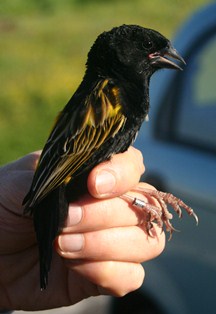
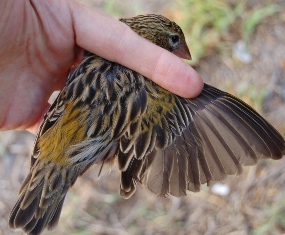
Identification. The Yellow Bishop Euplectes capensis breeding male is black and yellow. It differs from the Yellow-crowned Bishop in being larger and having a black head. It differs from the Yellow-mantled Weaver in having a shorter tail and yellow rump (not mantle). The non-breeding male is dull with bright yellow rump and shoulders, being the only Euplectes species with a brightly coloured rump in the non-breeding plumage. The female Yellow Bishop has an olive rump and is more heavily streaked below then the female Yellow-mantled Widowbird. Distribution.
Habitat. The Yellow Bishop inhabits montane grasslands in the north. It occupies some coastal and lowland areas in Tanzania. In South Africa, it ranges from coastal regions in macchia, cultivated lands, rank vegetation along streams and forest fringes up to mountain fynbos and high grasslands. Food. The Yellow Bishop feeds on seeds, mainly grass seeds, and also on cultivated maize, rice and millet. It also feeds on insects like caterpillars, bugs, termites and ants. It forages singly and in pairs, and when not breeding it forms mixed foraging flocks. Breeding. The Yellow Bishop is polygynous, with three or four females per male. It is solitary or found in small breeding groups. The male displays to females entering his territory, with yellow rump feathers puffed up and tail depressed, and flying on a zigzag course. The nest is domed with a side entrance, and placed above the ground in grass or in a small shrub. The nest is woven by the male from grass strips, and living grass may be woven into the structure. It is lined by the female with grass seedheads, which may project from the entrance to form a porch. The male nips off the tops of the herbs around the nest. The clutch is 2-4 eggs, and the eggs are very variable in colour. The female incubates the eggs and feeds the chicks, mainly by regurgitation. Many nests are lost to predation. The maximum recorded longevity is more than 11 years (see here). Old nests of the Yellow Bishop may be used by Karoo Prinias Prinia maculosa or Zebra Waxbills Amandava subflava. |
The above is based on Weaver Wednesday, a weekly series about weaver species.
This species text first appeared as
Weaver Wednesday [73]: Yellow Bishop on 2013-11-06
2. Breeding facts
| Pair bond Polygynous, with three or four females per male Breeding season Nov in Cameroon and Jul-Oct in Ethiopia; in DRCongo, Jul-Nov in Uele, Jan-Mar in Itombwe, Dec in Katanga, and Feb-Apr in Lubumbashi; in Kenya mainly Mar-Jun, also Nov-Feb, and May-Sept (dependent on rainfall) on Laikipia Plateau; Apr-May in Tanzania; Mar-May in Angola, Dec-Apr in Zambia, Jan-May in Malawi, Dec-Mar in Zimbabwe and Dec-Feb in Mozambique: in South Africa, Aug-Dec in winter-rainfall region, Nov-Mar in summer-rainfall area; often double-brooded Nest site placed 0.5-1.5 m above ground in grass or small shrub, male nips off tops of herbs around nest Nest building woven by male, lined by female Colony size Often solitary, and never truly colonial Clutch size 2-4 eggs Egg colour very variable, five basic types, (i) bluish-white and heavily speckled with reddish-brown, (ii) green-tinged light brown and heavily blotched and streaked with dark brown and grey, (iii) olive-brown with ash-brown spots, (iv) cream or very pale greenish, evenly covered in bold freckling of olive, sepia and grey, (v) pale bluish-grey, blotched and spotted with reddish-brown and olive-brown Egg size average size of 25 eggs 21.3 x 15 m (South Africa) Incubation incubation by female, 13-16 days, in captivity 13 days reported Chicks and nestling period chicks fed by female, primarily by regurgitation, nestling period 16-20 days (14-15 days also reported) |
Breeding information based on Handbook of the Birds of the World, Vol. 15.
3. Photos of Weaver Nests
 Vm 29128 |  Vm 28713 |  Vm 28710 |  Vm 15775 |  Vm 960 | 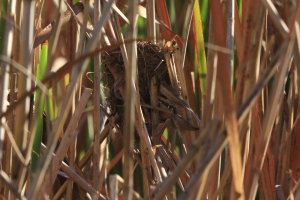 Vm 945 |
Thumb-nails of most recent PHOWN records - click on one to see its full record
See all PHOWN records for this species here.
PHOWN (Photos of Weaver Nests) provides valuable info on breeding distribution and colony sizes of weavers.
You can contribute by registering and submitting photos at Virtual Museum webpage.
4. Breeding distribution
Google map showing distribution (For species with small ranges you need to zoom in at the correct area to see the range):
yellow blob - range of weaver species; read more about this here.
![]() - PHOWN records with photos
- PHOWN records with photos
![]() - PHOWN records with no photos (Nest Record Cards, other records)
- PHOWN records with no photos (Nest Record Cards, other records)
![]() - Birdpix records
- Birdpix records
![]() - comments on out of range records, or interesting records
- comments on out of range records, or interesting records
![]() - type locality
- type locality
CLICK on the marker on the map to see individual record details.
5. Range changes
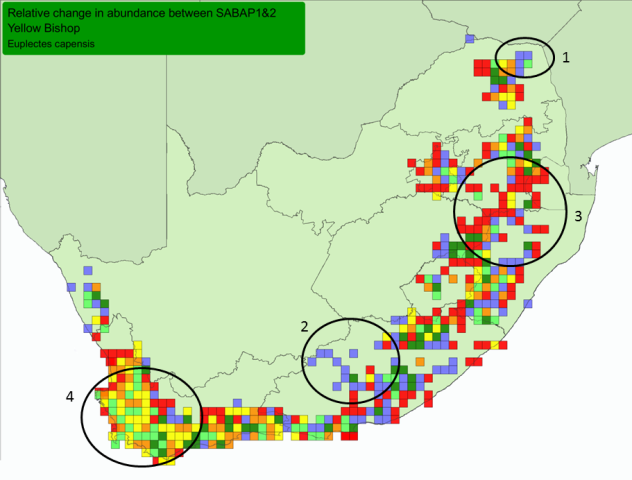
Red, orange and yellow = cells with very large, large, and small relative decreases Blue, dark green and light green = cells with very large, large and small relative increases. Cells = quarter-degree grid cells; Only cells with at least 4 checklists in both SABAP1&2 shown. All cells had this species recorded in SABAP1 or in SABAP2 or in both (more about interpretation at Biodiversity Observations 7.62: 1-13).
Range changes in SA
The points below match the points on the map above. Areas with very large increases include:
Areas with very large decreases include:
Areas with very small changes include:
Range changes elsewhereMozambique - new records from far north coast (SAFRING database). | |||||||||||||||||||||||||||||||||||
The above is based on Weaver Wednesday 3, a weekly series about range changes in South African weaver species.
This species text first appeared as
Weaver Wednesday 3 [256] - Range changes [19]: Yellow Bishop on 2017-05-10








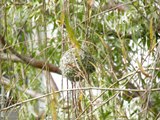


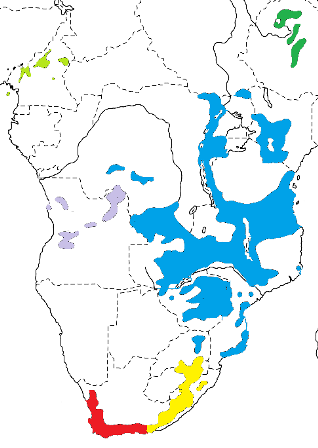 The Yellow Bishop has many described subspecies and here 6 of these are recognised, based on
The Yellow Bishop has many described subspecies and here 6 of these are recognised, based on 